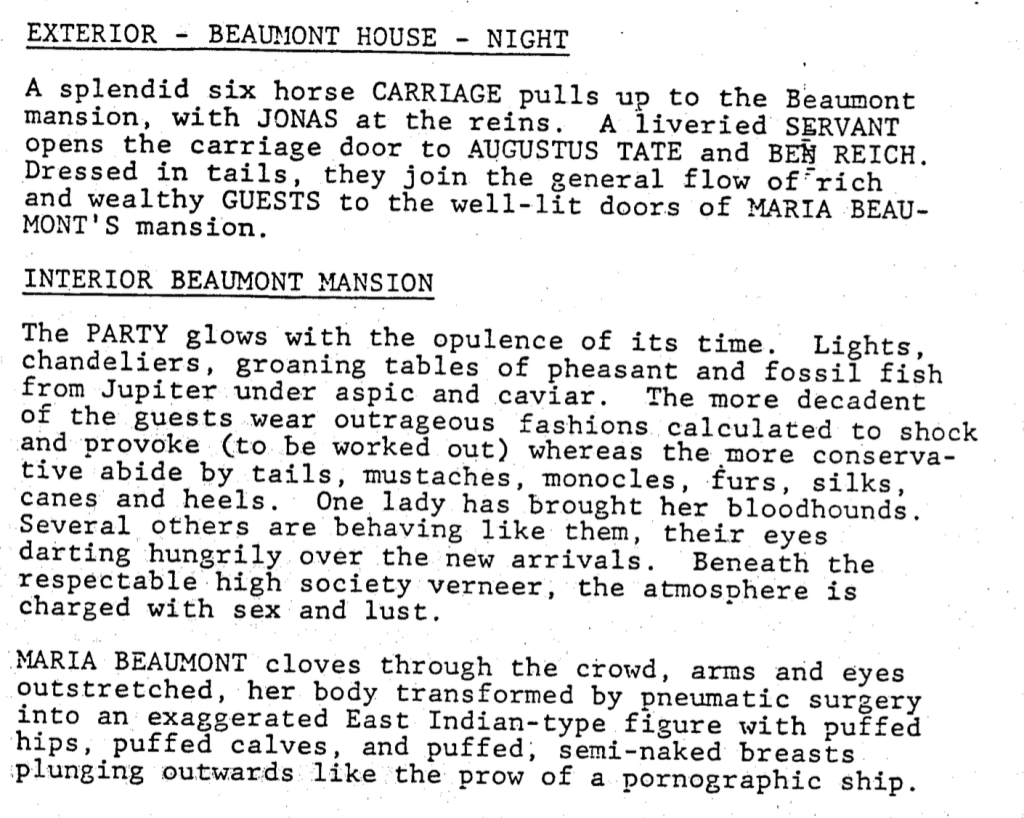Genre: Sci-Fi
Premise: In the year 2491, a Citizen Kane-like business mogul attempts to do something that hasn’t been successfully achieved in 80 years – murder a man without getting caught.
About: Before Oliver Stone became a visionary director, he was one of the most coveted writers in Hollywood. This was one of his early assignments, an adaptation of the science-fiction novel, “The Demolished Man,” the very first Hugo Award Winner (in 1953).
Writer: Oliver Stone (based on the novel by Alfred Bester)
Details: 122 pages – 1980 draft
Opening these old screenplays is a bit like opening an ancient scroll. You have no idea what you’re going to find. Another language? An entirely new screenwriting format?? Remember, this was pre-1990s, before the screenwriting market was deluged with How-To books. This meant that screenwriters took their time and wrote screenplays more like they wrote novels, with less emphasis on getting the reader in and out in 90 minutes.
It’s also nice to see a sci-fi adaptation from Stone, someone you don’t typically associate with the genre. However, as soon as you start reading “Demolished Man,” you can tell why he became attracted to the material. We have a CEO of an enormous company as our protagonist. We have money, corruption, and power. You could argue this is Wall Street in the year 2491. Let’s check it out.
Ben Reich, the CEO of Reich Industries, is a seriously wealthy man. He’s got products on Mars, on Jupiter’s moons, he’s even got an outpost at the edge of the galaxy. But Reich’s got a problem. His nemesis, Craye D’Courtney, is stealing all of his business. If he doesn’t do something soon, Reich Industries is going to be in some deep shit.
So Reich comes up with a plan. Murder Craye. That may be easy in 2017. But 2491 is a lot different. In the future, we have these people called “Espers” who have the ability to read minds. This has made murder impossible to get away with. An Esper can come in, read your mind, know you’re guilty, and it’s straight to the electric chair. Or whatever chair they use in 2491. The… laser… beam… chair?
However, Reich hires a first-class Esper, Tate, to stick with him throughout the murder and its aftermath. You see, Espers can protect against the mind-reading powers of other Espers. This allows Reich to successfully murder Craye D’Courtney at a party, and when the Esper police come by, they’re none the wiser on who did it.
One problem, though. As Reich was killing Craye, Craye’s daughter entered the room, saw the murder, and ran. So now Reich’s got a witness to the murder on the run. Which means he must find her and kill her too.
This begins a cat and mouse game between Reich and the lead Esper on the case, Liz Powell. Both of them go hunting through a grimy 2491 New York City to find this girl, a girl we learn nobody knew existed in the first place. Powell’s able to catch up with her first, but only after she’s been memory-wiped by a scientist who’s pacing her through a “regrowth” so that she can overcome the crippling shock of seeing her father killed.
Reich realizes that once the daughter regains her senses, she’s going to sing, which means Reich has to kill Powell before the daughter reboots. This forces the two sides into a showdown, where Powell recruits all the Espers to perform a mass Esper mind meld on Reich, in the hopes of stripping him of his monopolistic hold on New York, the U.S., the planet, and the solar system, for good.
I’m going to go out on a limb and say, if this is what people considered “award-winning science fiction” in 1953, Bester didn’t have much competition. I don’t think I’ve ever seen a script go south faster than this one. One second we’re engrossed in a compelling science-fiction murder investigation with tons of fresh ideas. The next we’re lost in some kind of bizarre drug-induced fever dream.
I’m talking this went from Philip K. Dick to L Ron Hubbard.
I coulda swore LSD didn’t hit the American streets until the 60s. Apparently, Bester got an early shipment. I mean, you expect this kind of stuff from Stone, who’d rather write a 20 page dream sequence than well-plotted third act. But Stone was working off material that was trippy long before he was.
Maybe it had to happen this way. This is how sci-fi began. Writers thought you threw as many ideas as you could possibly come up with into a giant novel stew and just the pure imagination of it all was satisfying to a public who had limited access to interesting ideas.
In time, we’ve learned that the “everything-and-the-kitchen-sink” approach rarely works. The best science fiction movies are simple. A clear set of rules are established early – such as being able to manipulate time and space a la The Matrix – then you spend the rest of the movie exploiting that simple rule-set.
The Esper stuff was interesting because it was a fresh way to look at murder. How do you murder someone if the detectives can read your mind? That’s a simple premise. They then exploited that premise. You solve this problem by employing a counter-Esper, someone who can block out the investigator’s powers. You’ve got a movie there.
Bester, before he went insane, also made the crafty decision to introduce the daughter into the mix. You see, if he doesn’t do that, this plot doesn’t have a purpose. The movie would be about Reich hoping the cops didn’t figure out he was the murderer. Think about that for a second. What is a character who’s “hoping something doesn’t happen” doing the whole movie? A whole lot of nothing.
Because the daughter witnessed the murder and escaped, Reich now has a goal – find and kill the daughter before she can identify him. A strong goal makes your hero ACTIVE, which gives your plot THRUST, which almost always, assuming you’ve done your job on the character end, results in an entertaining story.
Demolished Man is one of the few times this combination DIDN’T result in an entertaining story. And that’s because the writer kept throwing a bunch of random weird science-fiction shit at the story, further complicating things and taking us away from the core dramatic question – which was: would our main character get away with murder?
The daughter is captured by some scientist and reprogrammed to grow up from baby to adult in three weeks? What in the living fuch?? Reich is placed under some mind meld where one-by-one, the elements of the universe are stripped away from him until he doesn’t know which way is up? Uhhhh… are you kidding me? What happened to the story?????
That’s the key question, guys. And it’s the one you should always be asking yourself with whatever you’re writing. Am I sticking with the story? If you’re going off and screwing around with dream sequences and weird subplots that do nothing but distort the story’s purpose, you’re losing. You’re losing at screenwriting. Stay on track. Stay focused. Storytelling is simple-telling.
And one more thing. There are people who think I’m too hard on creativity. That when “challenging” material that doesn’t fit into the “proper” screenwriting paradigm like Baby Driver or Blade Runner 2049 or Upstream Color come around, I wrongly condemn them. That’s not true. I like challenging material if it’s a WELL-TOLD STORY. I loved Room. I liked Colossal. I liked Swiss Army Man. I loved Memento.
There’s a difference between mental masturbation and having a plan to tell a good story uniquely. Unfortunately, Demolished Man falls into the former category. And that’s too bad. Because it had the beginnings of a really cool film.
Screenplay link: Demolished Man
[ ] What the hell did I just read?
[x] wasn’t for me
[ ] worth the read
[ ] impressive
[ ] genius
What I learned: I’ve read about 100 scripts now with futuristic New Yorks. So I’ll give you some advice based on what I’ve found. Just making New York bigger than it is now isn’t enough. Giving New York a sprawling seedy underbelly isn’t enough. Those two things are in every single future New York I’ve read. If you’re going to write about future cities, you have to look for imaginative ways that redefine how we look at them. Try to outthink your competition. Ask yourself, “Is this thing that I’m adding something that nobody else has thought of before?” If not, keep trying. In Demolished Man’s New York, the buildings had gotten so incredibly tall, no sun reached the city anymore. It was all shadows. So they installed these giant artificial “Sun Embers” throughout the city to keep it lit during the day. I’d never seen that before. That’s the kind of imagination I want from you guys.



